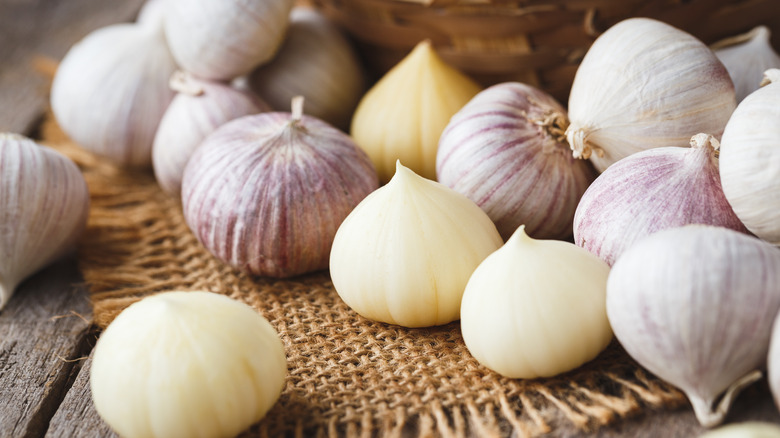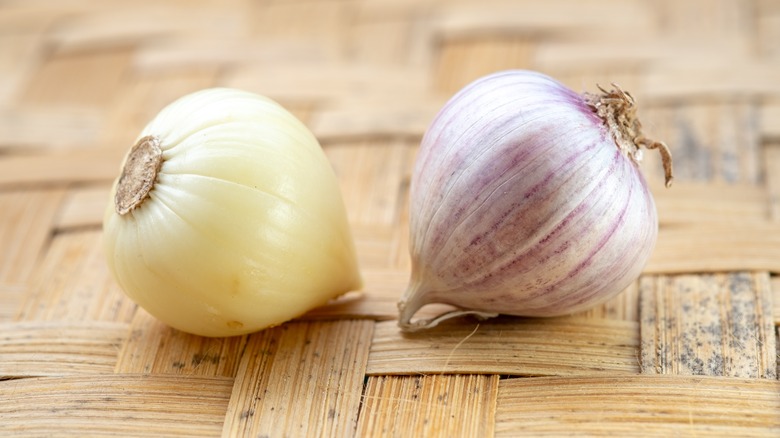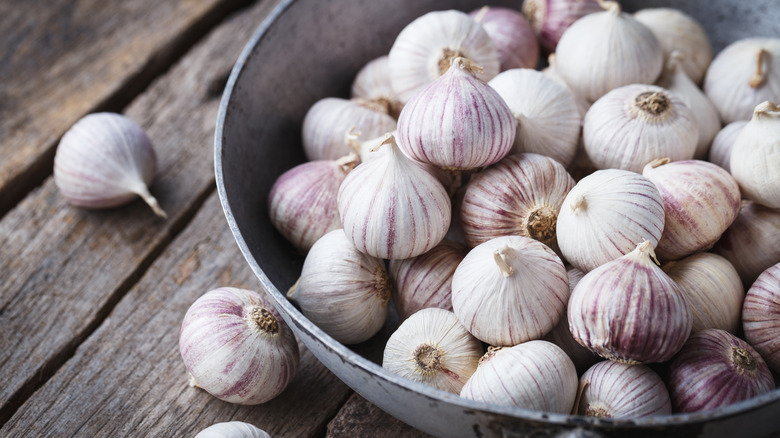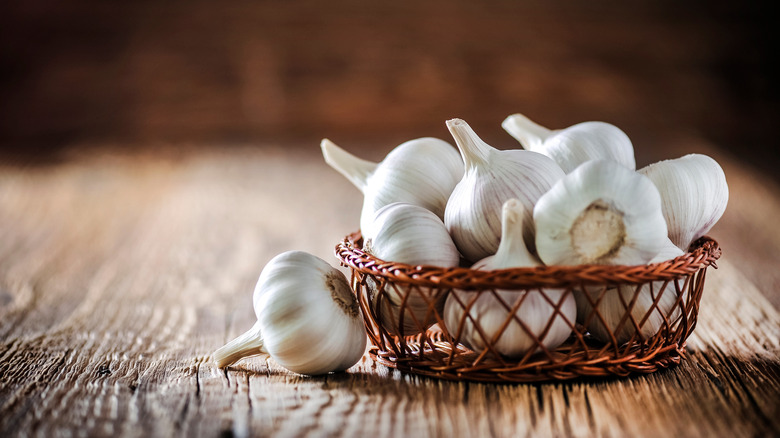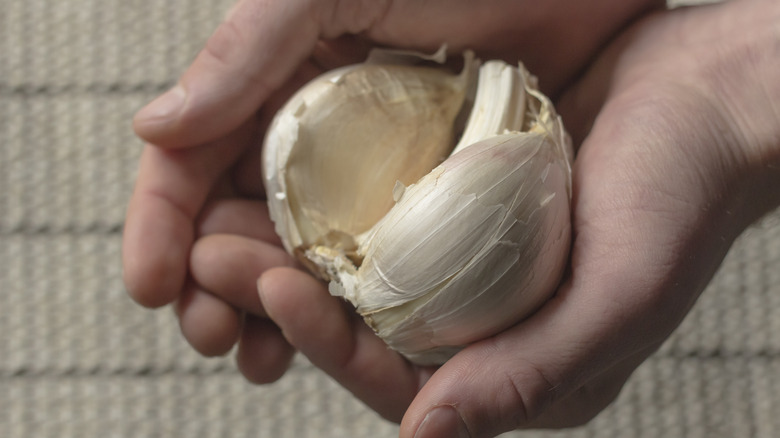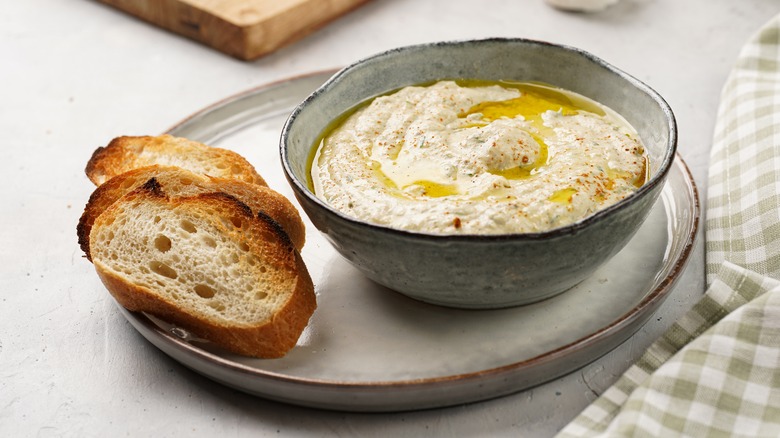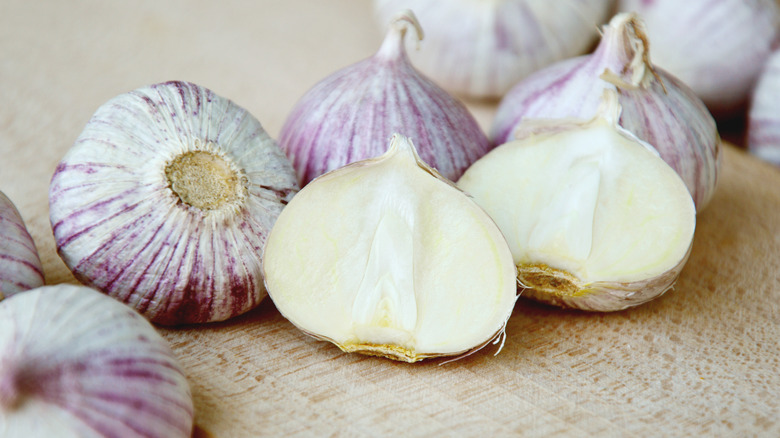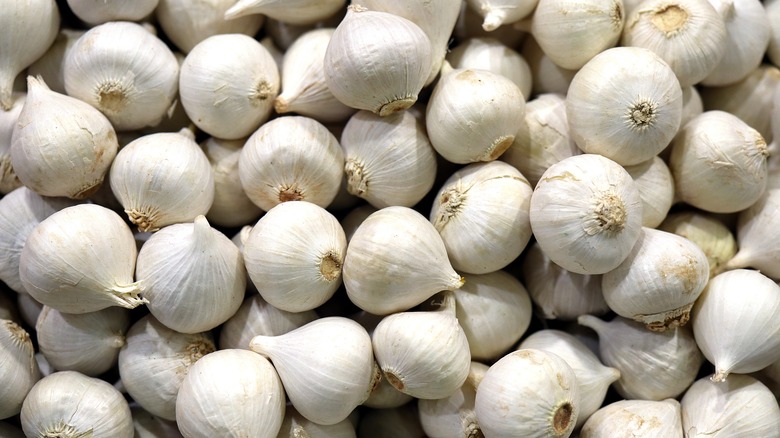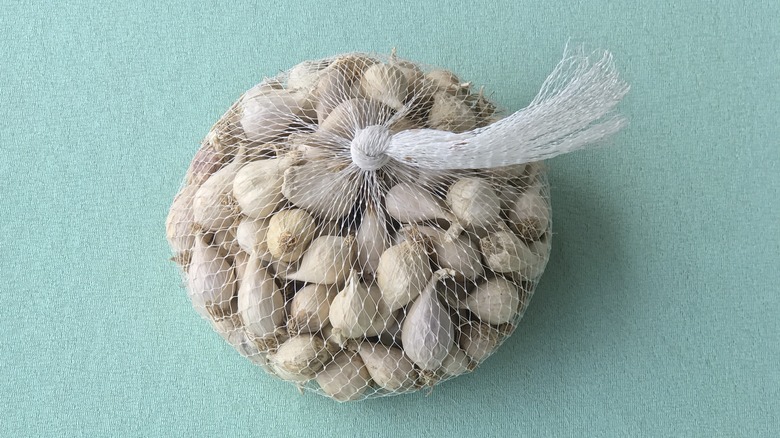Solo Garlic Is Exactly What It Sounds Like
One of my go-to ingredients as a chef has always been garlic. It is an ingredient that can provoke strong opinions both ways. Those who love it will use it in practically everything. Those who don't will avoid any dish where they can detect even a hint of it. The key is using it correctly and understanding the nuances of different kinds of garlic.
Garlic is divided into two basic types: hardneck and softneck. Broadly, the former thrives in cooler climates, has fewer cloves, and is easier to peel. The latter tends to thrive in warmer climes and has more prolific cloves that are challenging to peel. Within these types, you will find myriad varieties that range in size, texture, and color, from milky white to striated purple. Among the more unusual-looking specimens that defy logic is a softneck variety that looks more like a small onion known as solo garlic.
The first time I ran into solo garlic was several years ago when I obtained my weekly vegetable order from a local farm for my restaurant. The single giant bulbous orb intrigued me, prompting me to discover how best to use it in my recipes. This unique garlic variety has recently become a fad, with garlic lovers flocking to farmers markets and online to obtain one. Read on to discover where this garlic type comes from, what makes it distinct, and how best to add it to your culinary arsenal.
What is solo garlic?
Solo garlic, known as pearl, single bulb, monobulb, uni clove, Chengdu #2, ajo macho, and lazy garlic, is part of the Allium sativum species of domesticated garlic. This plant differs from other types in that it comes in the form of a single, large clove roughly the size of an entire head of garlic, ranging from 1 to 2 inches in diameter. The flesh of this garlic is surrounded by a paper-like skin ranging in color from snowy white to purplish gray.
Solo garlic is not a distinct variety but a product of its growing environment. The plant was initially domesticated in the Yunnan province in Southern China 7,000 years ago. This region tends to be on the warm side, which is favorable to the growth of solo garlic. Most garlic is planted in the late summer and early fall, thriving underground throughout the frosty winter and getting harvested late in the spring. When temperatures fail to get cold enough, the plant doesn't form multiple smaller cloves and instead yields one large clove.
The lucky adaptation creates a kind of garlic revered for its ease of preparation. Indeed, some cultures have viewed this happy accident as something fortuitous. In Mexico, where the plant is known as ajo macho, this garlic is used to bring opportunity and affluence to anyone holding it on their person in a pocket or bag. It is also considered a potent protection against evil when made into a candle and kept lit within the home.
What does solo garlic taste like?
Solo garlic is characterized by a slightly potent piquance conferred by sulfur compounds within its cells. This flavor can be spicy in its uncooked form and caramelized or nutty when cooked. Solo garlic tends to be more tempered in heat and less acrid, with a pronounced aroma that causes it to permeate your taste buds more thoroughly. For this reason, it can leave a more pervasive aftertaste that is distinct yet pleasant.
Garlic's flavor is contingent on how it is prepared, and that's true for solo garlic as well. The flavor tends to get stronger the finer the garlic is processed. As more surface area is exposed to oxygen, the sulfuric compounds within the cellular structure of the garlic become increasingly activated, making its flavor more pronounced.
For the mildest flavor, roast solo garlic before using it in a recipe or use it whole. To experience the full brightness of its flavor profile, slice, mince, or purée solo garlic using a microplane zester before adding it to a recipe. It is crucial to remember that a single clove of solo garlic is roughly the equivalent of a head of regular garlic, so don't overdo it.
How does solo garlic compare to regular garlic?
Botanically, solo garlic is identical to its multi-cloved cousins. Where it differs most is what it looks like. Its exterior looks somewhat more akin to a small onion. When you begin to peel away its skin, its resemblance to traditional varieties begins to be more prominent, with its flesh being a creamy hue and having a sticky, juicy texture.
Its aroma tends to be somewhat more pungent yet less aggressive than classic garlic, with an almost sweetish perfume-like nose. Its flavor is milder overall, with less heat and bitterness in its raw form. Again, this flavor can be tempered by roasting the whole solo garlic clove or adding it into a recipe whole versus slicing, mincing, or puréeing it.
Perhaps the most notable distinction between solo and regular garlic is its ease of preparation. This makes it highly appealing to many who would use the acrid specimen within a jar of pre-minced garlic rather than take the precious time needed to separate individual cloves and remove the papery skins from each one. Because solo garlic is a single clove, the skin is quickly disposed of, and the meat is ready to process for recipes without having the peels adhere to your fingers like they are infused with glue.
How does solo garlic compare with elephant garlic?
To the naked eye, elephant garlic strongly resembles solo garlic with multiple cloves. In actuality, these plants are unrelated. Elephant garlic, also known as great-headed or Oriental garlic, is not a member of the Allium sativum species of domesticated garlic, contrary to its moniker. It is a variety of the Allium ampeloprasum species of wild leek.
Elephant garlic grows similarly to traditional garlic, developing a bulb with an average of six large cloves rather than up to 20, encased in a paper-like skin. Like solo garlic, its peel is easier to remove, and its flesh has a similar, creamy hue. This is where the similarities end.
The flavor of elephant garlic is far more akin to that of a leek or onion. While it, too, is characterized by the release of those sulfuric compounds within the cellular structure of the flesh of the plant, it is slightly less pungent than both regular and solo garlic. That said, it can become overwhelming when used in excess because of the size of each clove.
Similar rules apply in terms of preparation. Roasting the head of elephant garlic yields a caramelized, nutty, sweet flavor, as does using it whole in a recipe. Serving it sliced, minced, or puréed can make it quite potent and overwhelming if used heavy-handedly.
How to cook with solo garlic
Because solo garlic is so easy to peel, it can conveniently be substituted for regular garlic in virtually any recipe. Always remember that it is not a one-to-one correlation to a clove of regular garlic but more like an equivalent to a head of garlic, with slightly more aromatic properties and less pungent spiciness or inherent bitterness.
The place where it likely shines the most is when roasted. The meat from roasted solo garlic can be spread onto bread, used in dips like hummus or baba ganoush, or incorporated into dressings and marinades for a sweeter and nuttier flavor than raw garlic.
Similarly, adding the whole clove into a soup or stew will confer a mellow, fragrant, sweet garlic flavor without overwhelming the dish. An example of this would be a classic 40-clove garlic chicken recipe. If using solo garlic, you would likely use two to three cloves to obtain an equivalent amount to 40 cloves of regular garlic.
Solo garlic is also uniquely suited to pickling because of its size and mellow flavor profile. This is something often seen in Vietnamese and other East Asian cuisines. It is also the preferred type of garlic for creating an Asian delicacy called black garlic. Black garlic is produced by slowly aging or incubating solo garlic under controlled temperatures and humidity until it becomes charcoal in hue, soft and sticky in texture, and takes on a subtle flavor that is simultaneously sweet, smoky, and savory.
Nutritional information about solo garlic
Like regular garlic, solo garlic is high in the sulfuric compound allicin. According to a research review published in Trends in Food Science & Technology, this compound has been shown to possess myriad health benefits. It is uniquely potent despite having a short lifespan thanks to being very easily absorbed. Its therapeutic uses include antioxidant, antibacterial, antifungal, anticancer, anti-asthmatic, antilipidemic, immunoregulatory, blood pressure lowering, and cardiovascular disease protective potential. It has also been shown to have hepatoprotective properties that may help reverse damage to liver tissues, as demonstrated in research published in BMC Complementary Medicine and Therapies.
According to a research review The Journal of Nutrition, cultures from ancient Egypt and Greece to Rome, China, and India have used garlic for medicinal purposes for centuries. Its therapeutic uses were so well known that it was often implemented to bolster productivity in laborers. It was purportedly administered to athletes competing in the inaugural Olympic games in Greece to help increase athletic performance.
Despite its lengthy use in health and wellness traditions of cultures across the globe and the extensive research that has been conducted establishing these purported myriad health benefits, the consumption of solo garlic may be contraindicated under some circumstances. The National Center for Complementary and Integrative Health notes that some may experience adverse effects, including gastrointestinal discomfort or an allergic reaction. Garlic is also not recommended for those on blood thinners, like Coumadin (aka warfarin), as it may promote bleeding.
Where to buy solo garlic
Your best bet to obtain fresh solo garlic will likely be a local farm or farmers market specializing in unique produce. Some grocery stores have started carrying it, but it gets confused with elephant garlic frequently by retailers, and, as we know, they're not the same thing. You may also obtain fresh solo garlic online from various gourmet produce retailers. Solo garlic can also be found online in pickled or dehydrated forms and its blackened iteration via various Asian or gourmet food retailers.
If you enjoy gardening, you can grow your own using bulbils from any garlic variety. Doing so requires finesse and knowing when to plant and harvest, depending on your unique climate. It also requires ample time, with some gardeners suggesting it takes up to two seasons to grow from start to finish. For better control of environmental factors, consider growing solo garlic indoors using a terracotta pot and plenty of access to abundant sunlight.
How to store solo garlic
Like a whole head of regular garlic, solo garlic is quite hardy when left intact still in its peel. It should be stored in a cool, dry place, away from sunlight or other heat sources, which will prevent the garlic from sprouting. Never leave solo garlic in a plastic bag. This will trap moisture, which can encourage the growth of mold. Lastly, if you live in a humid environment, consider investing in a dehumidifier for your pantry or kitchen to help increase the life expectancy of your garlic. Unpeeled solo garlic can last for up to six months if properly stored.
Once peeled, whether you leave it whole or chop it, solo garlic should always be transferred to an airtight container and kept in the refrigerator. This will prevent microbial growth and lock in aromas that will infiltrate anything else you have in the fridge. Peeled or chopped solo garlic will last approximately three days in the refrigerator.
Consider freezing peeled or chopped portions of solo garlic for prolonged storage. There are two ways to do this. You can place whole or chopped portions of solo garlic in an airtight container or freezer bag or freeze them in water in an ice cube tray. The latter is quick and easy to access for recipes but can cause some aroma to escape and permeate other foods in the freezer. Frozen solo garlic can last six to 12 months if kept at a constant temperature, which will prevent freezer burn.
